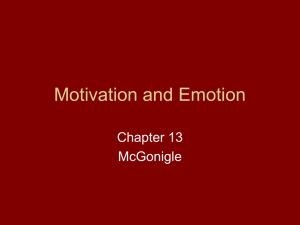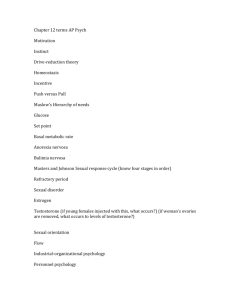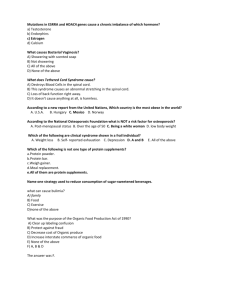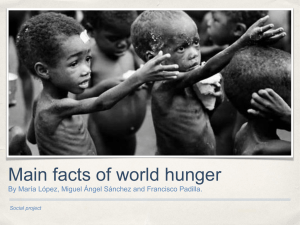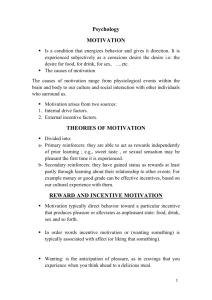How do we decide when and how much to eat?
advertisement
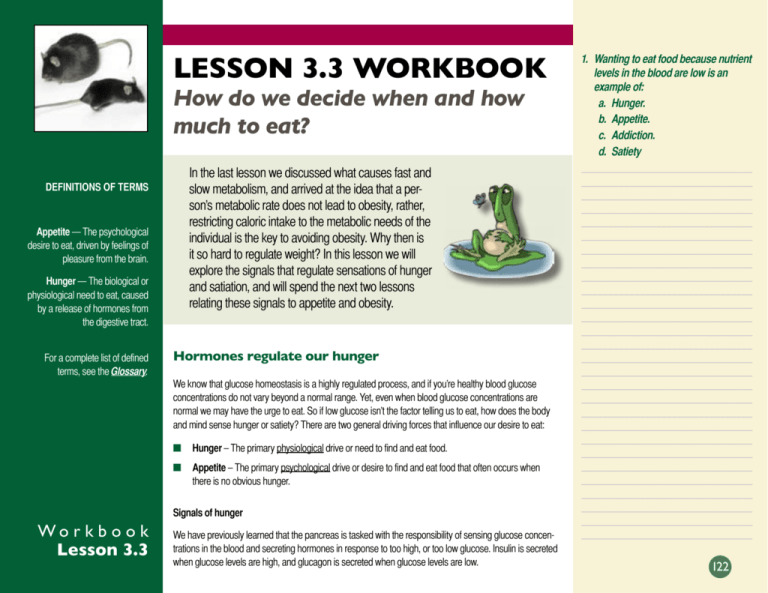
LESSON 3.3 WORKBOOK How do we decide when and how much to eat? DEFINITIONS OF TERMS Appetite — The psychological desire to eat, driven by feelings of pleasure from the brain. Hunger — The biological or physiological need to eat, caused by a release of hormones from the digestive tract. For a complete list of defined terms, see the Glossary. In the last lesson we discussed what causes fast and slow metabolism, and arrived at the idea that a person’s metabolic rate does not lead to obesity, rather, restricting caloric intake to the metabolic needs of the individual is the key to avoiding obesity. Why then is it so hard to regulate weight? In this lesson we will explore the signals that regulate sensations of hunger and satiation, and will spend the next two lessons relating these signals to appetite and obesity. Hormones regulate our hunger We know that glucose homeostasis is a highly regulated process, and if you’re healthy blood glucose concentrations do not vary beyond a normal range. Yet, even when blood glucose concentrations are normal we may have the urge to eat. So if low glucose isn’t the factor telling us to eat, how does the body and mind sense hunger or satiety? There are two general driving forces that influence our desire to eat: ■■ Hunger – The primary physiological drive or need to find and eat food. ■■ Appetite – The primary psychological drive or desire to find and eat food that often occurs when there is no obvious hunger. Signals of hunger Wo r k b o o k Lesson 3.3 We have previously learned that the pancreas is tasked with the responsibility of sensing glucose concentrations in the blood and secreting hormones in response to too high, or too low glucose. Insulin is secreted when glucose levels are high, and glucagon is secreted when glucose levels are low. 1. Wanting to eat food because nutrient levels in the blood are low is an example of: aa. Hunger. bb. Appetite. cc. Addiction. dd. Satiety ________________________________ ________________________________ ________________________________ ________________________________ ________________________________ ________________________________ ________________________________ ________________________________ ________________________________ ________________________________ ________________________________ ________________________________ ________________________________ ________________________________ ________________________________ ________________________________ ________________________________ ________________________________ ________________________________ ________________________________ ________________________________ ________________________________ ________________________________ ________________________________ ________________________________ ________________________________ ________________________________ ________________________________ 122 LESSON READINGS As you know, these hormones can travel to other cells and organs in the body, telling them to either release stored energy or to store incoming nutrients for later use. Likewise, other organs will release hormones that will travel to the brain, signaling that we either need to stop or start eating. The important organs (other than the brain) and the hormones in the process are: DEFINITIONS OF TERMS Circadian rhythm — A 24-hour biological cycle of activity that drives hormonal releases. For a complete list of defined terms, see the Glossary. ■■ The stomach releases ghrelin in response to low nutrients in the blood – this stimulates hunger. ■■ The pancreas releases insulin in response to blood glucose levels increasing – this makes you feel full. Pancreas – Insulin! Small Intestine – CCK! Stomach – Ghrelin! Large Intestine – PYY! Adipose – Leptin! Figure 1: Hormones are released from the digestive tract that send hunger or satiety signals to the brain. ■■ The adipose tissue releases leptin when energy stores are growing – this makes you feel full. ■■ The small intestine releases cholecystokinin (CCK) when fatty acids and some amino acids enter small intestine– this makes you feel full. ■■ The large intestine releases peptide YY (PYY) in response to feeding– this makes you feel full. Hormones regulating hunger can follow your sleep cycle Wo r k b o o k Lesson 3.3 Throughout the day and night several hormones in our body are released in a cycle called the circadian rhythm. Hormones that follow the circadian rhythm are responsible for making you sleepy at night time, and alert during the day time. Things like changing time zones and being exposed to too much blue light at nighttime can disrupt our circadian rhythm. Blue light is the wavelength of light we are exposed to throughout the day. Before electricity, the only way we obtained blue light exposure Midnight Noon Midnight was by the sun’s rays. Now we are exposed to blue light coming Figure 2: Hormones affected by the circadian rhythm are from televisions, computer released in a cyclical pattern throughout the day. 2. The circadian rhythm is: aa. The natural 24-hour cycle of the body. bb. Disrupted by blue light. cc. What makes you tired after sunset. dd. All of the above. ________________________________ ________________________________ ________________________________ ________________________________ ________________________________ ________________________________ ________________________________ ________________________________ ________________________________ ________________________________ ________________________________ ________________________________ ________________________________ ________________________________ ________________________________ ________________________________ ________________________________ ________________________________ ________________________________ ________________________________ ________________________________ ________________________________ ________________________________ ________________________________ ________________________________ ________________________________ ________________________________ 123 LESSON READINGS screens, cell phone screens and fluorescent light bulbs, which can all mimic daytime light in our brain. This in turn can have an effect on the release of some hormones. The release of ghrelin, insulin and leptin are all cyclical and may be influenced by the circadian rhythm. For example, people that constantly lack sleep, such as people that work the nightshift at their job, tend to have increased circulating ghrelin and decreased circulating leptin levels in their blood. This in turn leads to increased feelings of hunger, and may eventually lead to obesity. The next time you stay up all night see if you notice your hunger levels changing the following day! DEFINITIONS OF TERMS Hypothalamus — A region in the brain that coordinates homeostatic activity, controlling body temperature, thirst and hunger. Satiety — The feeling of being full, or sated. For a complete list of defined terms, see the Glossary. Wo r k b o o k Lesson 3.3 Our brain interprets signals sent from the body The organs of the body are important sensors and signalers of eating because they are the “feet on the ground” that know when nutrient and energy levels are getting too high or too low. But how does the brain interpret these signals into behaviors like eating or not eating? The hypothalamus is the control center of hunger The homeostatic regulation of food intake is under the control of the hypothalamus: a tiny structure in the base of the brain that is the master regulator of most of the body’s homeostatic mechanisms. The hypothalamus receives, coordinates and responds to metabolic cues and signals from the digestive system. By integrating these signals, the hypothalamus tells us when we need to eat to maintain our body weight. It is clear however, that higher brain centers above the hypothalamus have a huge influence on what and how much food we eat. The reward pathway, for example, controls our desire to eat, and may be to blame for food cravings. As we will see, our inability to forego these rewarding aspects of food can override the long-term homeostatic control of food intake, and can contribute to obesity. Hypothalamus Figure 3: The hypothalamus in the brain is the homeostatic regulator of food intake. We have known for many years that the hypothalamus plays a central role in driving our need to eat. In animal studies, placing a tiny lesion in the hypothalamus can cause the animal to become obese or lean, depending on where the lesion is put. These experiments have allowed us to determine which areas of the hypothalamus are 'hunger' centers (telling us to eat), or 'satiety' centers (telling us to stop eating). As we will see below, the hunger and satiety centers of the brain are like a toggle, switching back and forth as the combination of signals received from the body fluctuate. 3. How does the hypothalamus regulate energy homeostasis? aa. It makes us feel hungry or sated. bb. It regulates metabolic rate. cc. It leads to glucose uptake in the muscle. dd. It causes stored energy to be broken down. ________________________________ ________________________________ ________________________________ ________________________________ ________________________________ ________________________________ ________________________________ ________________________________ ________________________________ ________________________________ ________________________________ ________________________________ ________________________________ ________________________________ ________________________________ ________________________________ ________________________________ ________________________________ ________________________________ ________________________________ ________________________________ ________________________________ ________________________________ ________________________________ ________________________________ ________________________________ 124 LESSON READINGS The part of the hypothalamus that plays a key role in interpreting hunger and satiety signals is called the arcuate nucleus (ARC), as shown in the figure below. The ARC has two sets of neurons that control hunger in opposing ways: ■■ One set of neurons produces two molecules: neuropeptide Y (NPY) and agouti-related peptide (AgRP) that stimulate feeding and promote weight gain. DEFINITIONS OF TERMS Agouti-related Peptide (AgRP) — A peptide that is synthesized in the arcuate nucleus. Its release leads to feelings of hunger. Alpha-melanocyte-stimulating hormone (α-MSH) — A peptide that sends messages between neurons in the hypothalamus. Its release leads to feelings of fullness. Arcuate Nucleus (ARC) — A group of specialized neurons (nerve cells) in the hypothalamus. Neuropeptide Y (NPY) — A peptide that sends messages between neurons in the hypothalamus. Its release leads to feelings of hunger. For a complete list of defined terms, see the Glossary. Wo r k b o o k Lesson 3.3 ■■ The other set of neurons produces a hormone called alpha-melanocyte-stimulating hormone (α-MSH) that reduces appetite and promotes weight loss. What makes us eat? When nutrients in the blood get low, ghrelin is released from the stomach, which travels to the ARC in the hypothalamus and activates the release of AgRP and NPY. These molecules then go to the hunger center in the hypothalamus and tell us that we need to eat. We then get the feeling of hunger and eat! What makes us stop eating? Figure 4: Regulation of hunger and satiety in the hypothalamus involves hormones from the body communicating with the arcuate nucleus, which leads us to eat or to stop eating. A number of factors can be sensed and trigger us to stop eating. Food entering our digestive tract, glucose concentrations rising in our blood and triglycerides being sent off to storage in the adipose tissue are all cues that it is time to stop eating. When these things happen, leptin, insulin, CCK and PYY are all released from their respective tissues, and all travel to the ARC in the hypothalamus. This is where things start to get tricky! The presence of leptin, insulin, CCK and PYY in the ARC stimulates the production of α-MSH, which signals the satiety center and tells us to stop eating. Additionally, leptin, insulin, CCK and PYY in the ARC will inhibit the functions of ghrelin, thereby making us feel full in two ways: one, by stimulating the satiety center, and two, by inhibiting the hunger center. Some foods may make us feel fuller than others. Because CCK is only released in response to fat and some amino acids entering the small intestine, a high carbohydrate meal may not sufficiently trigger CCK secretion, and may not give us feelings of satiation. Also, recall that foods with a high glycemic index - like highly processed, sweet foods - cause blood glucose to peak and fall quickly. This produces a fast storage of energy followed by a drop in blood glucose that will lead to a fall in insulin and leptin, which allows ghrelin to stimulate hunger. 4. Eating a meal would stimulate the release of all of the following except: aa. Leptin. bb. Insulin. cc. Ghrelin. dd. CCK. ________________________________ ________________________________ ________________________________ ________________________________ ________________________________ ________________________________ ________________________________ ________________________________ ________________________________ ________________________________ ________________________________ ________________________________ ________________________________ ________________________________ ________________________________ ________________________________ ________________________________ ________________________________ ________________________________ ________________________________ ________________________________ ________________________________ ________________________________ ________________________________ ________________________________ ________________________________ ________________________________ ________________________________ 125 LESSON READINGS Stimulants of appetite When do you feel the urge to eat? Is it only when your body truly needs nutrients and energy? Probably not! We all get the urge to eat for a multitude of reasons, like boredom, or passing by our favorite ice cream shop. So if ghrelin isn’t stimulating this need to eat, what is? How are our senses linked to appetite? Figure 5: Simply thinking of food may make us feel hungry! We can be driven to eat simply by seeing or smelling food. This is because food activates the brain's reward center, which we will learn about in greater detail in the next lesson. By activating the reward center, we feel good after eating. Simply seeing or smelling a favorite food can activate the reward center and make us want to eat. There are some foods that give us more pleasure than others, and some people are more sensitive to getting pleasure from food than others. In general, people who experience more pleasure from eating certain foods tend to eat more, leading some researchers to believe that the brain’s reward center may play a central role in the development of obesity. On the other side of the equation, being hungry can actually increase our sense of smell. The release of ghrelin from the stomach can travel to cells that are responsible for smell and make them more sensitive. This is why the smell of food cooking is especially mouthwatering when you are hungry! Marketing food to our senses We live in a food-rich environment, and are constantly exposed to advertisements for food products. Food marketers can use our senses to sell us food even when we are not hungry. Some studies have shown that seeing a picture of a tantalizing food (like the pizza to the right) can activate the brain's reward pathways and make us want to eat. Using this knowledge, we can be driven to purchase a food simply by seeing a picture of it. Wo r k b o o k Lesson 3.3 Figure 6: Seeing images of our favorite foods can make us feel hungry even when we don't need nutrients. 5. Wanting to eat food because you smell it (not because your body needs it) is an example of: aa. Hunger. bb. Appetite. cc. Addiction. dd. Satiety. ________________________________ ________________________________ ________________________________ ________________________________ ________________________________ ________________________________ ________________________________ ________________________________ ________________________________ ________________________________ ________________________________ ________________________________ ________________________________ ________________________________ ________________________________ ________________________________ ________________________________ ________________________________ ________________________________ ________________________________ ________________________________ ________________________________ ________________________________ ________________________________ ________________________________ ________________________________ ________________________________ 126 STUDENT RESPONSES How can we use the knowledge of hypothalamus and hunger and satiety signals to formulate a drug for weight loss? What process or processes would you activate or inhibit and what would you predict the outcome and side effects to be? _____________________________________________________________________________________________________ _____________________________________________________________________________________________________ _____________________________________________________________________________________________________ _____________________________________________________________________________________________________ _____________________________________________________________________________________________________ _____________________________________________________________________________________________________ ____________________________________________________________________________________________________ Remember to identify your sources _____________________________________________________________________________________________________ _____________________________________________________________________________________________________ _____________________________________________________________________________________________________ _____________________________________________________________________________________________________ _____________________________________________________________________________________________________ _____________________________________________________________________________________________________ _____________________________________________________________________________________________________ _____________________________________________________________________________________________________ _____________________________________________________________________________________________________ _____________________________________________________________________________________________________ _____________________________________________________________________________________________________ _____________________________________________________________________________________________________ _____________________________________________________________________________________________________ _____________________________________________________________________________________________________ _____________________________________________________________________________________________________ _____________________________________________________________________________________________________ Wo r k b o o k Lesson 3.3 _____________________________________________________________________________________________________ ___________________________________________________________________________________________ 127 TERMS TERM For a complete list of defined terms, see the Glossary. Wo r k b o o k Lesson 3.3 DEFINITION Agouti-related Peptide (AgRP) A peptide that is synthesized in the arcuate nucleus. Its release leads to feelings of hunger. Alpha-melanocyte-stimu­ lating hormone (α-MSH) A peptide that sends messages between neurons in the hypothalamus. Its release leads to feelings of fullness. Appetite The psychological desire to eat, driven by feelings of pleasure from the brain. Arcuate Nucleus (ARC) A group of specialized neurons (nerve cells) in the hypothalamus. Circadian Rhythm A 24-hour biological cycle of activity that drives hormonal releases. Hunger The biological or physiological need to eat, caused by a release of hormones from the digestive tract. Hypothalamus A region in the brain that coordinates homeostatic activity, controlling body temperature, thirst and hunger. Neuropeptide Y (NPY) A peptide that sends messages between neurons in the hypothalamus. Its release leads to feelings of hunger. Satiety The feeling of being full, or sated. 128


